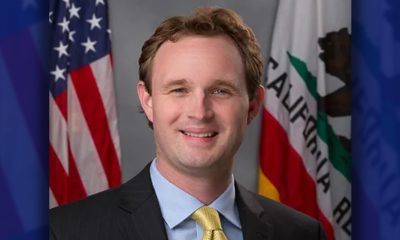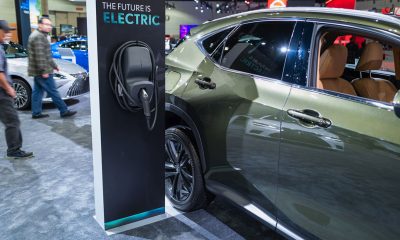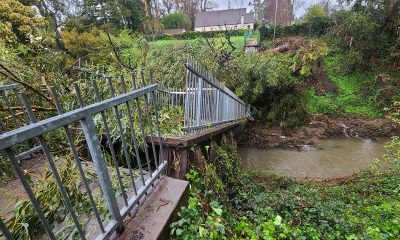Environment
San Leandro Opens Three Electric Vehicle Charging Stations for Public Use
The City of San Leandro announced that it has installed three new electric vehicle (EV) charging stations that are now available for public use.
Two of the stations are located at the City’s Downtown Garage, located at 122 Estudillo Av., and the third station is located at the City’s Wastewater Treatment Plant at 3000 Davis St.
“Electric vehicles ultimately save money for those who drive them and are good for the environment because these vehicles don’t directly generate any carbon emissions,” said Mayor Pauline Russo Cutter. “But one of the biggest impediments to more people being able to own these types of vehicles is finding a place to charge them.”
The stations have been installed as part of a wider effort known as the Bay Area Charge Ahead Project, a grant program funded by the California Energy Commission that is facilitating the installation of 152 EV charge ports throughout the Bay Area in high-priority areas.
In order to use the stations, members of the public need only to drive up and plug in (a Charge Point account is required). Users will be charged $1.50 per hour for the first four hours of charging, and $5.00 per hour thereafter. The Charge Point Level 2 stations provide power between 208 to 220 volts, which typically provide a full vehicle charge within four hours.
The Bay Area Charge Ahead Project is part of a regional collaboration being led by the California EV Alliance and its partners, including the Bay Area Climate Collaborative, a program of Prospect Silicon Valley.
“The Bay Area is the nation’s leading regional electric vehicle market on a per capita basis,” added Richard Schorske, executive director of the California EV Alliance. “Reaching our regional goal of 100,000 electric vehicles on the road by 2020 will result in over $100 million going into the local economy that would otherwise be spent on petroleum products coming from outside our region.”
There are nearly 40,000 plug-in vehicles and 2,500 charging spots in the Bay Area. Electric vehicle sales have grown steadily in California, exceeding the rate of adoption compared to conventional hybrids when first introduced.
In 2014, electric vehicles accounted for over five percent of auto sales, and are expected to grow according to state and independent projections. Battery costs, which are the most significant component of electric vehicle costs, are also estimated to decrease by up to 50% or more by 2020.
The increased use of electric vehicles will also help San Leandro achieve its Climate Action goals because these cars serve to reduce greenhouse gas emissions and produce less noise pollution. Electric vehicles also emit only 20 percent of the heat that is generated by conventional automobiles, which can help to cool down Bay Area cities during warm summer months.
For more information, contact Judy Walker of the San Leandro Department of Public Works at (510) 577-3437.
California Black Media
Gov. Newsom Goes to Washington to Advocate for California Priorities
Gov. Gavin Newsom traveled to Washington, D.C., for meetings with senior Biden-Harris Administration officials and members of California’s congressional delegation. During the week, he pushed for increased resources to improve public safety and quality of life in California.

By Bo Tefu, California Black Media
Gov. Gavin Newsom traveled to Washington, D.C., for meetings with senior Biden-Harris Administration officials and members of California’s congressional delegation.
During the week, he pushed for increased resources to improve public safety and quality of life in California.
“California is continuing our work to secure additional tools and resources to improve access to health care, clean air and water, and secure critical funding to support communities recovering from disasters,” said Newsom.
At the White House, Newsom met with President Joe Biden and key officials, advocating for disaster relief funding, healthcare expansion, and environmental protection. He also engaged in discussions with senior Biden-Harris officials, including Interior Secretary Deb Haaland, to address water quality improvements and the San Luis Dam project, which will support water supplies for two million Californians.
“Building on our strong partnership with the Biden-Harris Administration, California is working closely with the White House over the next two months to deliver the critical protections and resources our communities need,” Newsom said.
On Capitol Hill, Newsom met with California Senators Alex Padilla and Adam Schiff, along with other Congressional leaders, to emphasize the need to approve pending disaster funding, healthcare programs, and environmental protections. He also previewed California’s upcoming special session to proactively address potential federal challenges when President-elect Donald Trump is sworn into office.
Newsom’s discussions also focused on securing Medicaid waivers from the Center for Medicare & Medicaid Services (CMS) to enhance behavioral health services and reduce homelessness. The state seeks approval for the BH-CONNECT waiver, which would address behavioral health and homelessness, and the MCO Tax Waiver, which would provide over $20 billion for Medi-Cal to improve healthcare access.
Additionally, California is pushing for Clean Air Act waivers from the U.S. Environmental Protection Agency (EPA), which are crucial for enforcing air quality regulations. These measures are projected to prevent 11,000 premature deaths and provide $116 billion in health benefits over the next three decades, according to the Governor’s office.
Activism
LIVE! — TOWN HALL ON RACISM AND ITS IMPACT — THURS. 11.14.24 5PM PST
Join us for a LIVE Virtual Town Hall on the Impact of Racism hosted by Post News Group Journalist Carla Thomas and featuring Oakland, CA NAACP President Cynthia Adams & other Special Guests.
Thursday, November 14, 2024, 5 p.m. – 6:30 p.m. PST


Join us for a LIVE Virtual Town Hall on the Impact of Racism hosted by Post News Group Journalist Carla Thomas and featuring Oakland, CA NAACP President Cynthia Adams & other Special Guests.
Thursday, November 14, 2024
5 p.m. – 6:30 p.m. PST
Discussion Topics:
• Since the pandemic, what battles have the NAACP fought nationally, and how have they impacted us locally?
• What trends are you seeing concerning Racism? Is it more covert or overt?
• What are the top 5 issues resulting from racism in our communities?
• How do racial and other types of discrimination impact local communities?
• What are the most effective ways our community can combat racism and hate?
Your questions and comments will be shared LIVE with the moderators and viewers during the broadcast.
STREAMED LIVE!
FACEBOOK: facebook.com/PostNewsGroup
YOUTUBE: youtube.com/blackpressusatv
X: twitter.com/blackpressusa
Business
Gov. Newsom Issues Executive Order to Tackle Rising Electric Bills
Gov. Gavin Newsom has issued an executive order to help alleviate the financial burden of skyrocketing electric bills on residents. This directive instructs the state’s Public Utilities Commission (PUC) and Energy Commission to identify strategies to lower electricity costs and prevent rapid increases in the future.

By Bo Tefu, California Black Media
Gov. Gavin Newsom has issued an executive order to help alleviate the financial burden of skyrocketing electric bills on residents. This directive instructs the state’s Public Utilities Commission (PUC) and Energy Commission to identify strategies to lower electricity costs and prevent rapid increases in the future.
Among the key actions proposed, the governor emphasized a closer examination of utility expenditures related to wildfire mitigation, which accounts for about 13% of residential electric bills.
Newsom underscored the state’s commitment to balancing affordability with environmental goals.
“We’re taking action to address rising electricity costs and save consumers money on their bills,” said Newsom. “California is proving that we can address affordability concerns as we continue our world-leading efforts to combat the climate crisis.”
California now has the second-highest electric rates in the country, trailing only Hawaii, with residential bills having surged as much as 110% over the past decade. The largest utilities, including Pacific Gas & Electric, Southern California Edison, and San Diego Gas & Electric, have seen rate hikes of 20% to 50% in just the last three years, approved by the state’s regulatory bodies.
The executive order also directs the California Air Resources Board (CARB) to explore increasing the California Climate Credit, which provides some relief on energy costs for residents. Additionally, the PUC is urged to pursue federal funding opportunities to further reduce electric expenses.
While consumer advocates welcomed the governor’s focus on lowering costs, concerns were raised regarding potential cuts to essential clean energy programs. CALPIRG, a consumer group, pointed out that the real issue behind high utility bills is wasteful spending by utilities and urged greater accountability.
-

 California Black Media4 weeks ago
California Black Media4 weeks agoCalifornia to Offer $43.7 Million in Federal Grants to Combat Hate Crimes
-

 Black History4 weeks ago
Black History4 weeks agoEmeline King: A Trailblazer in the Automotive Industry
-

 California Black Media4 weeks ago
California Black Media4 weeks agoCalifornia Department of Aging Offers Free Resources for Family Caregivers in November
-

 California Black Media4 weeks ago
California Black Media4 weeks agoGov. Newsom Goes to Washington to Advocate for California Priorities
-

 Activism3 weeks ago
Activism3 weeks agoOakland Post: Week of November 27 – December 3, 2024
-

 Activism4 weeks ago
Activism4 weeks agoOCCUR Hosts “Faith Forward” Conference in Oakland
-

 Activism4 weeks ago
Activism4 weeks agoRichmond Seniors Still Having a Ball After 25 Years
-

 Bay Area4 weeks ago
Bay Area4 weeks agoRichmond’s New Fire Chief Sworn In


























































